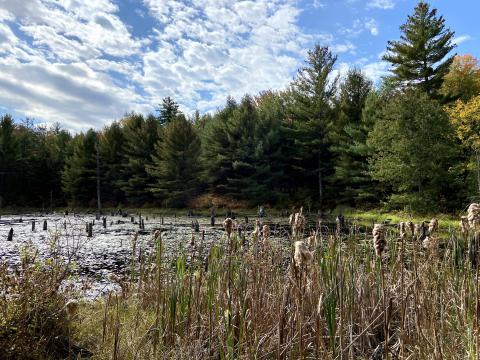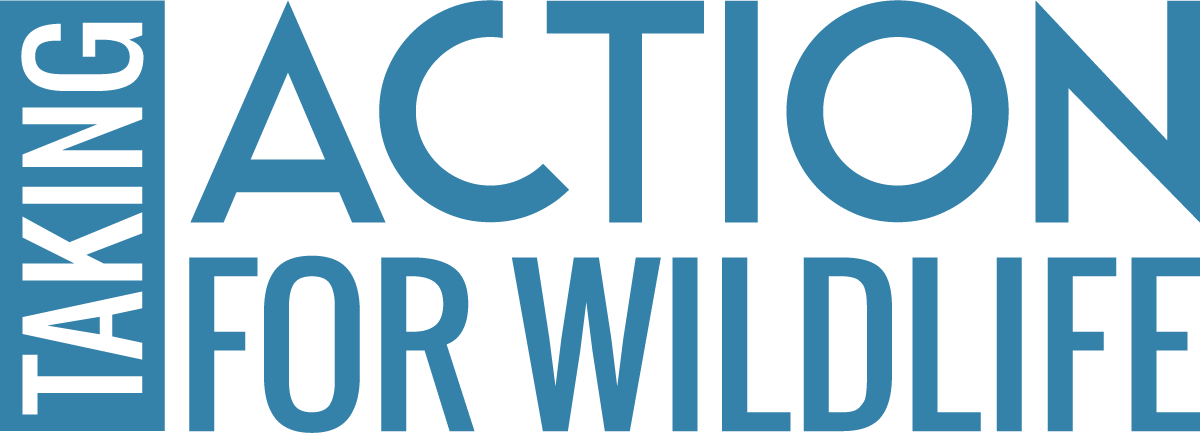
View of the Birch Ridge Community Forest in New Durham protected by Aquatic Resource Mitigation Funds.
Photo: Cheryl Bondi, NH DES
Wetlands are among the most biologically diverse, productive, and unique habitats on earth. No other part of our landscape provides so many benefits at so little cost to the public. Wetlands play a role in flood control, water quality maintenance and improvement, groundwater discharge and recharge, shoreline stabilization, fish and wildlife habitat, recreation, and education. However, wetlands and shorelines in NH are impacted by development resulting in a loss of these important resources. To help mitigate the loss of wetlands and streams in NH, communities may access state and federal funds paid into the NH Aquatic Resource Mitigation In-Lieu Fee (NH ARM ILF) program to help restore, enhance and preserve wetlands and streams.
To mitigate for the loss of wetlands impacted by development, the US Army Corps of Engineers allow applicants to fulfill their compensatory mitigation requirements by purchasing mitigation credits from the NH ARM ILF Program. The funds generated from the sale of mitigation credits can be used for projects that restore, establish, or protect aquatic resources as mitigation for permits issued subject to Section 404 of the Clean Water Act, Section 10 of the Rivers and Harbors of Act, and Waters/Resources of the State. Restoration projects involve the manipulation of the physical, chemical, or biological characteristics of a site with the goal of returning natural/historic functions to a former or degraded aquatic resource. Establishment of wetlands includes the manipulation of the physical, chemical, or biological characteristics present to develop an aquatic resource that did not previously exist at an upland site. Preservation projects include the removal of a threat to, or preventing the decline or, aquatic resources by an action in or near those aquatic resources. The Corps operates under a programmatic goal of “No Net Loss”. “No Net Loss” can be actualized in restoring and/or rehabilitating lost functions of streams and/or wetlands. Restoration projects should be considered first, before enhancement and establishment (creation). NH has more than 100 In-Lieu Fee projects administered by the NH Department of Environmental Services.
On the state level, New Hampshire Aquatic Resource Mitigation Program aims to sustain the functions and values of aquatic resources through protection, enhancement and restoration of wetlands and streams, to compensate for the loss from development and other impacts. Mitigation is required when a development project impacts more than 10,000 sq. ft. of wetland and more than 100 linear feet of streams. There are four options for mitigation in New Hampshire and these may be used singly or in combination to create a mitigation package. A site must be in the same watershed as the permitted impacts, when practicable. Land Preservation is the permanent protection of a valuable aquatic resource and its critical buffer area to ensure that the water body and upland area remains in a natural and undeveloped condition. Restoration is the reestablishment of a filled, dredged, or drained wetland to its historic condition, to restore its lost functions. Enhancement is activities done within existing wetlands that heighten or improve wetland and stream functions. Wetland creation is the construction of a wetland in an upland area, which involves excavation of a site to achieve adequate hydrologic features, followed by the importation of wetland soils and establishment of wetland vegetation. In-Lieu Fee Payment is the last option for wetland mitigation. If no practicable local mitigation opportunities exist, then payment into New Hampshire’s Aquatic Resource Mitigation Fund (ARM) is an option. NHDES uses the funds to support projects that will compensate for the functions and values lost in the same watershed for permitted impacts. The amount of ARM funds available varies from year to year depending on the impacts to wetlands and streams from construction and development.
Aquatic Resource Mitigation Funds can also be used with other funding programs to restore streams and surface waters. NH DES has several programs to help communities with restoration and enhancement of surface waters including the Coastal Program. A Living Shoreline is a nature based approach to shore stabilization in tidal waters. It is a management practice that provides erosion control benefits; protects, restores or enhances natural shoreline habitat; and maintains coastal processes through the strategic placement of plants, stone, sand fill and other structural organic materials. This helps provide habitat value and protects against coastal hazards. The ARM Fund provides money to remove tidal restrictions including dikes, berms and levees and replaces them with plants and stone and fill to create more natural tidal functions.
Another NH DES program that promotes the use of ARM funds is the New Hampshire Stream Crossing Initiative. This Initiative works to address the impacts of inadequate stream crossings on aquatic passage and public safety. This is a multiagency collaboration between NH Geological Survey, the Wetlands Bureau and four other state agencies created to assess and inventory the conditions of stream crossings statewide. Aquatic Mitigation Funds are available to enhance the functions and values of streams in areas important to wildlife including Wildlife Action Plan highest ranked habitat and streams with documented connectivity in a wildlife corridor. NH DES has several resources to explore to learn more about aquatic habitat and critical natural resource areas. You can find more information on the data available on the NHDES Data and Mapping page as well as the ARM Mapper.
By Barbara Richter, Executive Director, NH Association of Conservation Commissions
Winter 2021 Taking Action for Wildlife Newsletter
Top Photo: Lori Sommer, NH Department of Environmental Services


